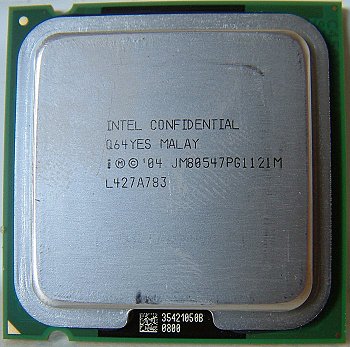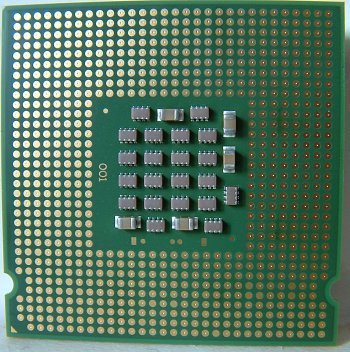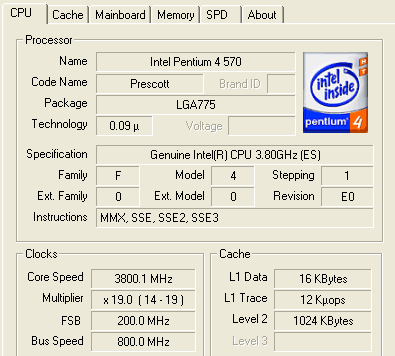A first look. 570J?
Intel's launch of its performance i925XE chipset, with the Memory Controller Hub running 66MHz faster than the incumbent i925X's 200MHz FSB, should have been accompanied by a range of new compliant CPUs. That's always been the way with chipset's system bus hikes in the past. However, at the time of writing, only a 3.46GHz Extreme Edition Pentium 4 CPU natively matched the i925XE's 266MHz (1066MHz quad pumped) MCH. That's still true with the launch of the Pentium 4 570J, too. Intel has simply achieved the extra 200MHz clock speed over and above a 560 model by increasing the multiplier up to a heady 19x.
There's nothing new in terms of form factor or appearance. This could be any one of several LGA775 processors. Intel's been using an integrated heatspreader for the entire Pentium 4 line. It makes implicit sense; you wouldn't want to crush a near-£500 CPU with an ill-fitting heatsink. AMD's also recognised the benefits of such an approach and used a similar system on its Athlon 64 line.

The two rival companies differ on how the processor should make contact with a motherboard. Intel, as you can see, has abandoned the traditional approach of having contact pins connected to the CPU itself. Rather, it says, having contact pads is a more sensible idea. The requisite pins are located directly within a compliant board's socket. I suppose it makes it more difficult for a user to damage processors which tend to be more costly to replace than mainboards. The days of straightening out errant pins is long gone. Some have cited concern over the ease by which an LGA775 socket's pins can be broken through mishandling. I've installed and removed LGA775 on a continual basis for months now and not managed to damage one yet, and I'm not the most careful of users, it has to be said.

Other than an obvious 200MHz jump in clock speed over a 3.6GHz 560 model, only the geeks amongst you will be able to discern the difference between this processor and the most of the current premier 5xx range.
E0-stepping
For the past month or so, Intel has been steadily updating the core stepping on both Pentium 4 Prescott S478 and LGA775 processors from the current D0 to E0. The new stepping will be differentiated from the incumbent by adding the suffix 'J' to model numbers. Technology upgrades from the change can be grouped into three segments, like so:
Execute Disable Bit (a.k.a. NX or XD)
This technology has also be called No-Execute Bit and NX bit and has been around in its Itanium processors for a while now. It's actually very similar to AMD's current Enhanced Virus Protection. The basic premise is that malicious code is prevented from running from in certain designated memory areas. The kind of attacks Intel and AMD has in mind are those targetted towards buffer overflows. That occurs when programs write more information into the buffer than what's been allocated in memory. Worms can then execute their own code and gain control of the program. In other words, Execute Disable Bit works by disabling the possibility of buffer overflows through not allowing code to be executed in certain memory pages that have already been classed as No Execute. So no more viruses for you?. It's not quite that simple. A number of recent viruses don't use the buffer to execute. Examples include SoBig, Bugbear, and Avril. Both AMD and Intel will readily admit, if pushed, that most viruses cannot be halted via XD technology, simply because they don't execute through the now-protected buffer.
For it to work, though, one needs both Intel's Physical Address Extensions (PAE-36) and an XD-enabled OS. For the home user, Windows XP Service Pack 2 comes to mind. Bear in mind that XD protection is limited in itself and I'd urge vigilance through the use of third-party anti-virus software and firewalls. It's a step in the right direction, sure, but is only a step and not a leap.
Enhanced Halt State (C1E)
If you used one word to describe the Prescott CPU, what would it be?. I bet what springs into most peoples' minds is hot. There's just no getting away from it. Intel's premier Prescotts have a Thermal Design Point (TDP) in excess of 100w. That's pretty worrying it itself, but when you combine that kind of wattage output with a die size that's barely over 100mm², effective heat transfer is always going to be problematic. Intel has long understood that their desktop CPUs spend a vast proportion of time simply idling.
My personal 3.2GHz Northwood is rarely tasked to do anything more than open up HomeSite and MSN Messenger. In view of this, the E0-stepping processors will use an enhanced halt state which dynamically lowers voltage and frequency when idling. Think of it as an improved version of SpeedStep or, for that matter, something akin to AMD's Cool'n'Quiet technology. The natural upshot is quieter systems for folks, like me, who don't stress the CPU on a continual basis. Not much good for the SETI crowd, though, eh?. Intel states that the C1E command is only supported in LGA775 Prescotts. Also, one needs a BIOS that's 'aware' of the halt command.
Thermal Monitoring 2
Thermal Monitoring 2 is inextricably linked in with Enhanced Halt State. Both lower frequency and voltage in order to reduce overall power consumption. The key difference is that TM2 is designed to lower CPU temperature when it has exceeded the maximum permissible die limit. Again, a TM2-supporting BIOS is required for this feature to work.
Summary
There's nothing radically new in the 3.8GHz Pentium 4 Prescott. It still rides on a 200MHz FSB and has now incorporated a couple of hardware, AMD-like features that are currently propagating through the rest of the LGA775 range. My only real disappointment is that it won't be released in a 266MHz FSB flavour. That leaves a 3.46GHz Extreme Edition as the only CPU capable of running on an i925XE chipset at its native speed. Having to pay, say, £700, for that privilege seems awfully obtuse of Intel.
Let's now see how it performs against 4 other premier Intel-based CPUs and 5 AMD Athlon 64s juggernauts.









